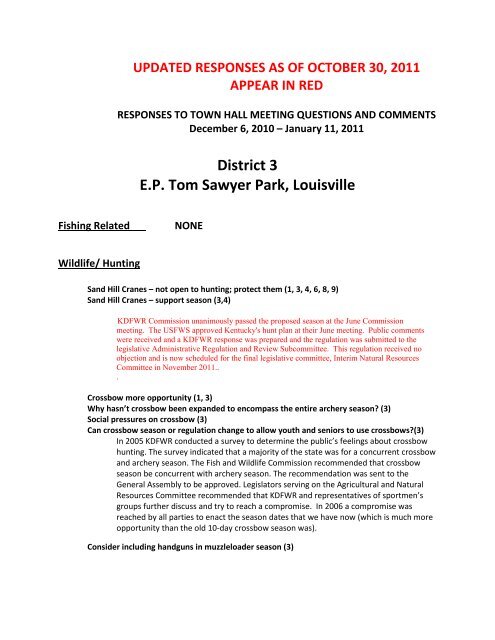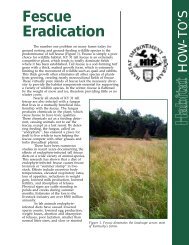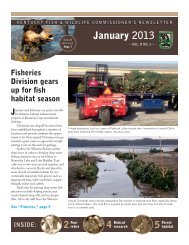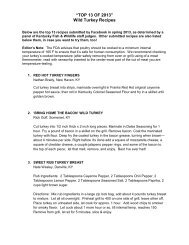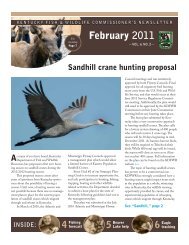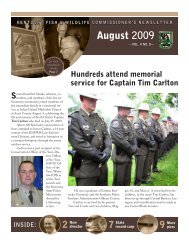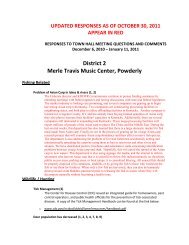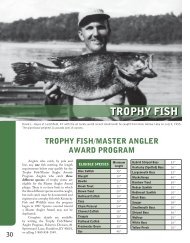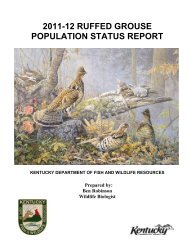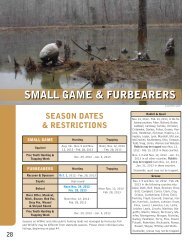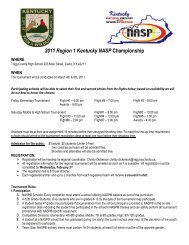District 3 E.P. Tom Sawyer Park, Louisville - Kentucky Department of ...
District 3 E.P. Tom Sawyer Park, Louisville - Kentucky Department of ...
District 3 E.P. Tom Sawyer Park, Louisville - Kentucky Department of ...
Create successful ePaper yourself
Turn your PDF publications into a flip-book with our unique Google optimized e-Paper software.
UPDATED RESPONSES AS OF OCTOBER 30, 2011<br />
APPEAR IN RED<br />
RESPONSES TO TOWN HALL MEETING QUESTIONS AND COMMENTS<br />
December 6, 2010 – January 11, 2011<br />
Fishing Related NONE<br />
Wildlife/ Hunting<br />
<strong>District</strong> 3<br />
E.P. <strong>Tom</strong> <strong>Sawyer</strong> <strong>Park</strong>, <strong>Louisville</strong><br />
Sand Hill Cranes – not open to hunting; protect them (1, 3, 4, 6, 8, 9)<br />
Sand Hill Cranes – support season (3,4)<br />
KDFWR Commission unanimously passed the proposed season at the June Commission<br />
meeting. The USFWS approved <strong>Kentucky</strong>'s hunt plan at their June meeting. Public comments<br />
were received and a KDFWR response was prepared and the regulation was submitted to the<br />
legislative Administrative Regulation and Review Subcommittee. This regulation received no<br />
objection and is now scheduled for the final legislative committee, Interim Natural Resources<br />
Committee in November 2011..<br />
.<br />
Crossbow more opportunity (1, 3)<br />
Why hasn’t crossbow been expanded to encompass the entire archery season? (3)<br />
Social pressures on crossbow (3)<br />
Can crossbow season or regulation change to allow youth and seniors to use crossbows?(3)<br />
In 2005 KDFWR conducted a survey to determine the public’s feelings about crossbow<br />
hunting. The survey indicated that a majority <strong>of</strong> the state was for a concurrent crossbow<br />
and archery season. The Fish and Wildlife Commission recommended that crossbow<br />
season be concurrent with archery season. The recommendation was sent to the<br />
General Assembly to be approved. Legislators serving on the Agricultural and Natural<br />
Resources Committee recommended that KDFWR and representatives <strong>of</strong> sportmen’s<br />
groups further discuss and try to reach a compromise. In 2006 a compromise was<br />
reached by all parties to enact the season dates that we have now (which is much more<br />
opportunity than the old 10-day crossbow season was).<br />
Consider including handguns in muzzleloader season (3)
Muzzleloading handguns are included in the season. Adding any form <strong>of</strong> centerfire<br />
weapon to the muzzleloading season not only violates the spirit <strong>of</strong> having an exclusive<br />
season, it makes things more difficult for law enforcement.<br />
Deer population has decreased (1, 2, 3, 4, 7, 8, 9)<br />
Current statewide deer population trends are nearly stable to slightly decreasing. Over<br />
the past few years deer zones in many counties have been made more restrictive to try<br />
to boost the deer population. KDFWR deer biologists look at each county’s deer<br />
population trend every year. Based on that population trend a county’s zone can be<br />
changed to better manage the deer population in the county. A county’s deer zone is<br />
determined by a combination <strong>of</strong> many things. Along with the population model, deer<br />
vehicle collision numbers, crop damage complaints, and hunter satisfaction are all taken<br />
into account when determining what a county’s zone should be.<br />
Depredation tags – who gets them? How many do they get? Post who gets tags on website.<br />
Hunters could help get rid <strong>of</strong> the problem deer. (3)<br />
Landowner crop depredation tags are issued by KDFWR law enforcement <strong>of</strong>ficers and<br />
wildlife biologists. An <strong>of</strong>ficer or biologist will come to the property and assess the<br />
amount <strong>of</strong> damage. He or she will determine how many tags are needed to control the<br />
damage issue and then issue the tags to the landowner. It is then up to the landowner<br />
to decide who will harvest the deer. Each damage tag recipient must complete a<br />
shooter designation form to record who will be the one harvesting the animal. All<br />
antlers from antlered deer killed on depredation tags must be turned over to KDFWR.<br />
Staff always encourages landowners to control deer via hunter access.<br />
Change baiting laws during hunting season (3)<br />
Wild turkeys are extremely susceptible to baiting or feeding and the use <strong>of</strong> those methods for<br />
hunting purposes would undoubtedly lead to local, if not regional, overharvest in <strong>Kentucky</strong>.<br />
Therefore, the use <strong>of</strong> bait will not be considered for the take <strong>of</strong> turkeys during the spring season<br />
when harvest pressure is greatest. However, the KDFWR will examine the regulatory wording <strong>of</strong><br />
other states and evaluate the potential for including a legal distance for hunting on property where<br />
feeding <strong>of</strong> wildlife occurs in the fall.<br />
Change Turkey season dates (1, 3, 7)<br />
The spring season structure in <strong>Kentucky</strong> is established to maximize harvest opportunity while<br />
minimizing negative effects to breeding and reproductive output. Our opening day <strong>of</strong> the Saturday<br />
closest to April 15 allows exceptional harvest opportunity, but after a significant proportion <strong>of</strong><br />
hens have been bred. This strategy has produced record and near-record spring harvests since its<br />
implementation. For those desiring an earlier opening date, from 2012-2015 the spring season<br />
will open earlier, on the second Saturday in April.<br />
Change Muzzeloader season (2, 3, 7)<br />
There is simply no time or place to move or expand the muzzleloader season. Deer gun<br />
hunters have to balance hunting time in the field with small game hunters, archery<br />
hunters, waterfowl hunters, predator hunters, and elk hunters. When season lengths<br />
and dates are changed for one user group it affects another hunting user group.<br />
Although it might make sense to one user group to make a date change, such changes<br />
are negatively viewed by other user groups.
Spring Season on Turkey moving to 2 nd Saturday in April. Are we planning on doing it again?<br />
The existing spring turkey regulation defines the opening day <strong>of</strong> turkey season as the<br />
Saturday closest to April 15. As such, the season opener fluctuates between the second<br />
and third Saturday <strong>of</strong> April between years. Beginning in 2012 and lasting until 2014 the<br />
opening date for the spring turkey season in <strong>Kentucky</strong> will occur on the second Saturday<br />
in April.<br />
Concerns on decline <strong>of</strong> small game & seasons (rabbits, quail, grouse) (1, 2, 3, 4, 5, 7, 8 ,9)<br />
The <strong>Department</strong> shares the concern for decline <strong>of</strong> small game. The seasons continue to<br />
be a popular debate with overlap <strong>of</strong> deer seasons and creating a single season that ends<br />
sometime in February. KDFWR has been one <strong>of</strong> the national leaders in restoration for<br />
bobwhite (mgt will also benefit rabbits). We also continue to move towards a more<br />
active forest management program on WMAs and through private lands efforts that will<br />
benefit ruffed grouse.<br />
KDFWR is working to create a cooperative program for private land owners to support small<br />
game management practices, which will include evaluating cost-benefit <strong>of</strong> existing tactics and<br />
developing critical measures <strong>of</strong> success.<br />
What is being done for small game hunting in the 3 rd <strong>District</strong>? (3)<br />
The Sinking Creek bobwhite focal area is underway with a seasonal biologist in-place<br />
promoting private lands management. An Environmental Quality Incentives Program<br />
grassland focus area was also established here through the efforts <strong>of</strong> the <strong>Department</strong><br />
and conservation partners. Yellowbank WMA has increased activity for the<br />
management <strong>of</strong> small game habitat in the last few years. Commonwealth Chapter <strong>of</strong><br />
Quail Forever has provided outstanding support for equipment on that area as well.<br />
Quail Quota Hunt on Peabody – stop rabbit hunting the day before the quota hunt & while<br />
they are hunting. (3)<br />
This will be evaluated each year after the seasons. As <strong>of</strong> now the impact <strong>of</strong> rabbit hunting seems<br />
negligible and this format allows us to provide opportunity for both groups.<br />
1 deer a day on public land, public land hunter is being slighted. Allow same opportunities on<br />
public land and private (3)<br />
The 1 deer per day rule was requested by a Commissioner out <strong>of</strong> concern that some<br />
WMAs may be over pressured if hunters were allowed to take more than 1 deer per<br />
day.<br />
Youth Involvement ( 1, 2, 3, 4, 5, 6, 7, 8, 9)<br />
Change youth season (2, 4, 7, 9)<br />
In October – November when temperatures are milder (2)<br />
2 days is not enough! Needs to be longer.(4)<br />
No change to youth seasons is currently recommended. Current youth seasons are the best<br />
compromise at this point.<br />
1,000 Elk tags were too many (3)<br />
Based on statistical models and ground counts <strong>of</strong> elk, the population is sufficient to<br />
handle this level <strong>of</strong> harvest without decreasing the overall herd. The low natural
mortality rate and high calving rate allows us to harvest at this level and still maintain a<br />
healthy population.<br />
Law Enforcement Related<br />
Get a raise and get them some help/Need a game warden in our county<br />
Budgetary restraints make it difficult to give raises even though we all know that they<br />
deserve them. The Division is in the process <strong>of</strong> identifying the next group <strong>of</strong> counties to<br />
be hired for conservation <strong>of</strong>ficer.<br />
Other<br />
Upland Bird License<br />
KDFWR has already a “Conservation Permit” provided for in regulation 301 KAR 3:022,<br />
which at a cost <strong>of</strong> $10 annually, could be defined for use as a “birding license” or other<br />
wildlife-watcher permit. Currently this permit remains inactive. The department is<br />
aware that some states <strong>of</strong>fer similar permits or “habitat stamps” that establish a userpay<br />
system for more non-traditional participants in fish and wildlife related activities.<br />
KDFWR plans to look more formally at these opportunities as part <strong>of</strong> our planned priceelasticity<br />
study in 2011.<br />
Decline in License Sales? Are youth and landowners counted?<br />
In <strong>Kentucky</strong>, youth under the age <strong>of</strong> 12 are not required to purchase a hunting license;<br />
whereas youth under the age <strong>of</strong> 16 are not required to purchase a fishing license. Also,<br />
landowners in <strong>Kentucky</strong>, along with their “dependents” and “tenants” are not required<br />
to purchase either hunting or fishing licenses if they hunt or fish on their specific<br />
property. See KRS 150.170. Because each <strong>of</strong> these groups is license “exempt”, there is<br />
no method to determine an accurate count <strong>of</strong> youth or landowners, except to say that<br />
they are not included in the license sales data. (Note: Some youth and landowners,<br />
even though they are not required, may still purchase hunting and fishing licenses and<br />
therefore would be counted in the license sales data should they do so.)<br />
Fees on Otter Creek—Discounts<br />
The Otter Creek Outdoor Recreational Area is now open and <strong>of</strong>fers a variety <strong>of</strong> outdoor activities.<br />
There are no special discounts at this time; however, KDFWR intends to evaluate our usage and<br />
sales data in 2012 (after our first year <strong>of</strong> operation) to determine the need for possible amendments<br />
to our license and permit structure.<br />
Right to Hunt—are we doing it?
Yes. KDFWR supported House Bill 1 in <strong>Kentucky</strong>’s 2011 General Assembly. It passed<br />
both chambers and was delivered to the Secretary <strong>of</strong> State’s <strong>of</strong>fice on March 8, 2011,<br />
who will ensure that the amendment be placed on the ballot for the November, 2012<br />
general election.<br />
Why were camp fees raised to $215? (3)<br />
Fees were raised to cover the increasing cost <strong>of</strong> transporting children to camp as well as<br />
to <strong>of</strong>fset other increased costs associated with operating the conservation camps.<br />
More resources to camps & scholarships? (3,7)<br />
Fundraising efforts <strong>of</strong> the KY Fish & Wildlife Foundation have greatly increased the<br />
resources available to the department’s conservation camps. The foundation makes<br />
funds available for construction projects and has helped increase the number <strong>of</strong> camp<br />
scholarships available for deserving children.<br />
For more information on the <strong>Kentucky</strong> Fish and Wildlife Foundation, refer to their website at<br />
www.kentuckywildlife.com.<br />
Is there a program that adults can get involved with to help get kids outdoors?<br />
Become a volunteer hunter education instructor, volunteer with the aquatic education<br />
program; take a child on a mentor hunt, volunteer with the Archery in the Schools<br />
program at your local school.<br />
Start an Explore Bowhunting program in your area. Work with the department to start a fishing<br />
event in your county.<br />
Expand the Becoming an Outdoors Woman (BOW) program. (1,3,6)<br />
F&W has met with State <strong>Park</strong>s to discuss expanding the Becoming an Outdoors Woman<br />
programs to parks around the state.<br />
The department needs to target 7 th & 8 th grade kids and make conservation programs<br />
mandatory for high school kids.<br />
The department currently uses its resources to <strong>of</strong>fer programs to 4th, 5th, and 6th grade students<br />
instead <strong>of</strong> focusing on older students. The department's conservation programs are a good fit for<br />
elementary schools. Children in elementary schools are easier to work with and respond better to<br />
the department programs. Approximately 70,000 students receive conservation programs during<br />
the school year or attend conservation camp. The department does not have the resources to<br />
conduct additional programs for older students. The <strong>Kentucky</strong> <strong>Department</strong> <strong>of</strong> Fish and Wildlife<br />
Resources conservation programs are voluntary and schools decide if they want the programs.<br />
Consumptive use <strong>of</strong> wildlife, how do we get it to the table and show folks it is a renewable<br />
resource? (3)
Harvesting wild game and fish is a sustainable, renewable, resource. The department<br />
has highlighted the process <strong>of</strong> cleaning and preparing wild game with the <strong>Kentucky</strong><br />
Afield Television show and through <strong>Kentucky</strong> Afield Magazine. The television show<br />
regularly features cooking recipes and tips with host Tim Farmer. In addition, the<br />
department produced a popular video on deer dressing and processing.<br />
Why was the Bowman Field Office closed? (3)<br />
The Bowman Field <strong>of</strong>fice was closed in 2004. The <strong>of</strong>fice was closed as a result <strong>of</strong> a<br />
mandated agency budget reduction. The <strong>of</strong>fice received minimal visitation and was<br />
expensive to operate.<br />
How do we survive declining license sales and continue expanding (3)<br />
Ask every angler and hunter to turn 10 non-sportsmen into sportsmen. We also need to<br />
expand our user base to include financially supportive non hunting and non-angling<br />
activities: wildlife viewing, non motorized watercraft registration fees (canoes and<br />
kayaks).<br />
Decline in license sales? Are youth and landowners counted? (3)<br />
No, however we are exploring cost effective way to encourage registration <strong>of</strong> these nonlicense<br />
purchasing user groups.<br />
Horses on WMAs – Horseback riding on WMAs (2, 3, 5)<br />
Need access to additional trails (3)<br />
Managing recreational use is a balancing act. The intended purposes <strong>of</strong> WMAs are to provide for<br />
wildlife conservation, habitat management, hunting, and other wildlife-related recreation. Other<br />
recreational opportunities are provided when economically and logistically possible, as long as<br />
they do not interfere with the primary intended purpose <strong>of</strong> the property. Currently, we have<br />
approximately 200 miles <strong>of</strong> designated horse trails on 14 WMAs in the state and one Outdoor<br />
Recreation Area. Horseback riding is also allowed on over 500 miles <strong>of</strong> unpaved WMA roadways.<br />
The <strong>Department</strong> has actually expanded horseback riding opportunity in the last 10 years. For<br />
example, a cooperative agreement was recently reached with Floyd County for over 20 miles <strong>of</strong><br />
additional horseback riding opportunity on Dewey Lake WMA. Though not a WMA, the<br />
<strong>Department</strong> has also provided new trail riding opportunity at Otter Creek Outdoor Recreation Area<br />
in Meade County. Furthermore, each time the <strong>Department</strong> acquires additional WMAs, there is<br />
usually increased opportunity in the form <strong>of</strong> unpaved roadways that may exist on the properties.<br />
Birding License (3)<br />
WMAs are purchased and managed with hunting and fishing license dollars and federal<br />
matching grant funds that are by law, specifically earmarked for wildlife restoration and<br />
management. Birdwatching is a natural by-product <strong>of</strong> wildlife restoration and<br />
management that does not require additional revenue to support.<br />
Against horseback riding on WMAs – WMAs were bought with sportsman’s dollars
Horseback riding lowers the quality <strong>of</strong> a hunt. (3)<br />
Indeed, many WMAs were bought with sportsmen’s dollars. The <strong>Department</strong> also manages<br />
numerous WMAs on lands on lands not owned by the <strong>Department</strong>, such as on U.S. Army Corps <strong>of</strong><br />
Engineers' property or Coal Company lands. We manage WMAs for multiple recreational uses in<br />
addition to our primary mission. In many cases, a reasonable balance can be attained without<br />
conflict. The <strong>Department</strong> always strives to provide quality hunting opportunities while also<br />
managing lands for other recreational uses. For example, horseback riding is prohibited on<br />
WMAs when firearms season is open for deer, turkey, or elk. Some WMAs have hiking trails<br />
open to horseback riding, while others do not. On some public hunting lands that are managed<br />
but not owned by the <strong>Department</strong>, the decision on whether horseback riding is allowed rests with<br />
the wishes <strong>of</strong> that particular landowner. Regardless, we will continue to protect the rights and<br />
concerns <strong>of</strong> our primary customers, the sportsmen and women <strong>of</strong> <strong>Kentucky</strong>. We own and/or<br />
manage these lands in trust for them.<br />
Need point person on horseback riding (3)<br />
The <strong>Department</strong> has a point person, Mark Cramer, and other employees who work with<br />
the Tourism, Arts, and Heritage Cabinet to help support hunting, fishing, wildlife<br />
watching, and other types <strong>of</strong> Adventure Tourism activities, such as horseback riding,<br />
paddlesports, hiking, and mountain biking. The <strong>Department</strong> is a member and<br />
participates on the <strong>Kentucky</strong> Recreational Trail Authority to help support expansion <strong>of</strong><br />
trail opportunities in <strong>Kentucky</strong>.<br />
What is the status <strong>of</strong> free ranging horses and cattle being moved, and then elk being poached<br />
in retaliation? (3)<br />
Free ranging horses and cattle on Wildlife Management Areas (WMA) are prohibited (<br />
KRS 150.640.) The <strong>Department</strong> attempts to contact the owner to remove cattle and<br />
horses on our land. As a last resort, the <strong>Department</strong> will remove this livestock if the<br />
landowner cannot be located or determined. Poaching <strong>of</strong> elk in retaliation <strong>of</strong> this action<br />
is difficult to prove, but remains against the law. The public is encouraged to report any<br />
and all poaching (1-800-25-ALERT) for law enforcement investigation and potential<br />
prosecution.<br />
Wanton Waste Law should be in <strong>Kentucky</strong>. (3,4)<br />
<strong>Kentucky</strong> does not have a wanton waste law that prohibits the “waste” <strong>of</strong> edible meat<br />
taken from a game/fish species. Several states do have these types <strong>of</strong> laws. Federal<br />
wanton waste laws have long been in place regarding waterfowl hunting. KDFWR can<br />
certainly entertain discussions to determine if that is viable for <strong>Kentucky</strong> in reference to<br />
other species. Anyone may contact the agency and request to be heard by its<br />
commission on any applicable issue regarding wildlife laws.
Need more places to hunt (1, 2, 3, 5, 6, 7, 8, 9)<br />
Over the last four years and with the commitment <strong>of</strong> $1 million per year, KDFWR has increased,<br />
by close to 10 thousand acres, the amount <strong>of</strong> land owned by the department and now available for<br />
public access. Within these newly owned areas, the department has now made available nearly<br />
4,000 acres, specifically located in and around the state’s most populous area (i.e., the Golden<br />
Triangle <strong>of</strong> <strong>Louisville</strong>, Lexington and Northern <strong>Kentucky</strong>). Further, the department averages each<br />
year approximately 150 thousand acres in private landowner access agreements, which makes<br />
even more land available to the public. Aside from new hunting opportunities, KDFWR has also<br />
developed 13 new bank access sites and more than 30 boating access sites in the last four years;<br />
whereas the department now <strong>of</strong>fers 34 new lake fishing opportunities in and around <strong>Kentucky</strong>’s<br />
urban areas through our Fishing in Neighborhoods program.


